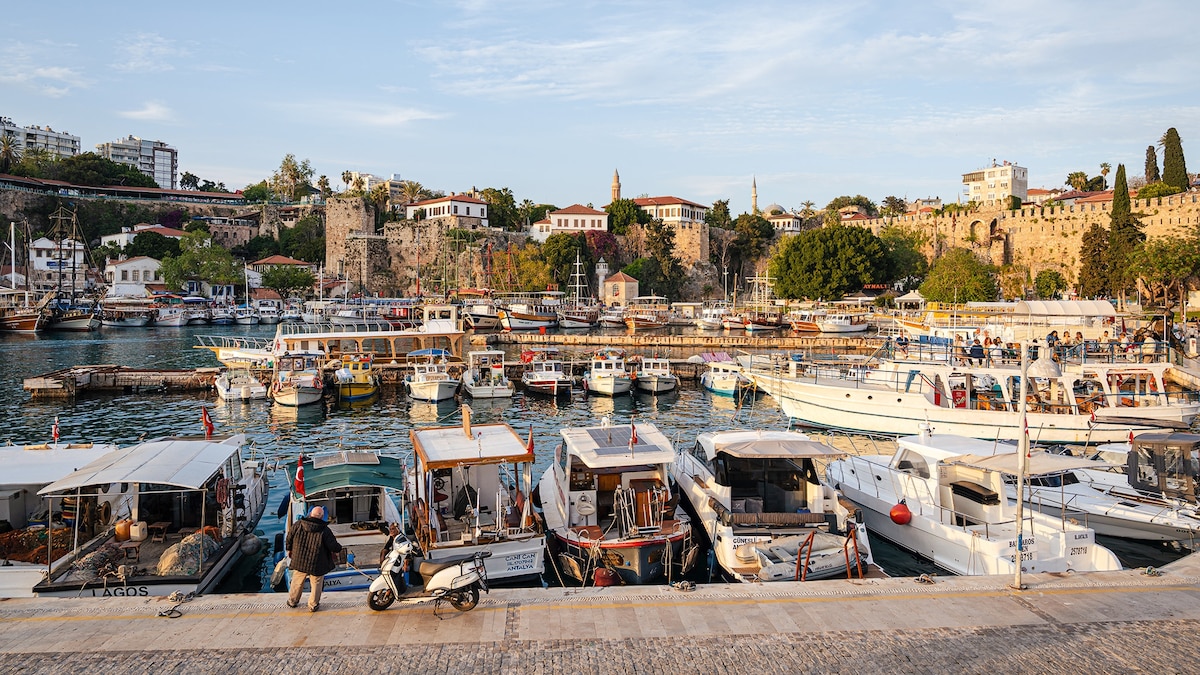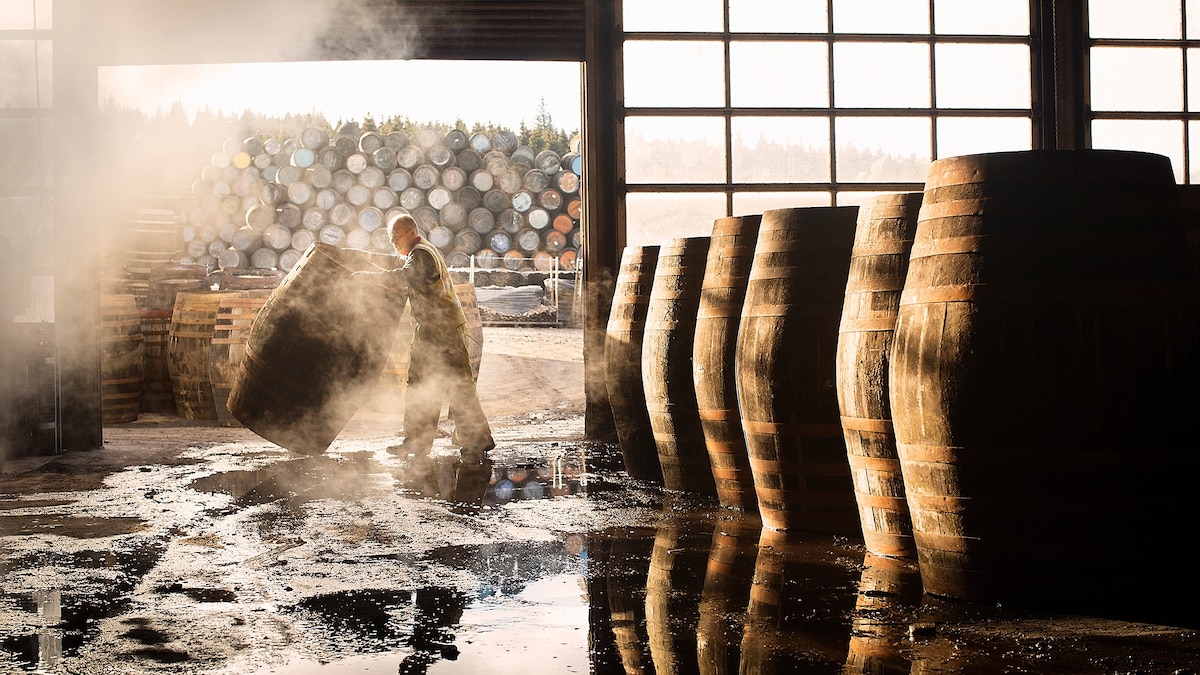Now Reading: Beyond the beach, Antalya makes for a cultural city break
-
01
Beyond the beach, Antalya makes for a cultural city break
Beyond the beach, Antalya makes for a cultural city break

This article was produced by National Geographic Traveller (UK).
Gateway to the Turkish Riviera, Antalya basks in the sunshine on the country’s southern Mediterranean coast, hugging the gulf that bears its name. Modern but with a picturesque, ancient heart, the city centres around a Roman-era harbour and the lattice of cobblestone lanes that make up the old town Kaleiçi (meaning ‘within the castle’), which is dotted with centuries-old mosques and restored Ottoman houses. It’s here that locals pause for long mezze lunches beneath waves of fuschia bougainvillea, or sit with an ice cream to soak up the sight of the Taurus Mountains rising in the distance beyond the bay.
Much like Rome, this is a city that wears its history on its sleeve, with stretches of two-thousand-year-old walls, imposing gateways and historic mansions scattered liberally throughout its core. The nearby ruins of the ancient cities of Perge and Aspendos offer a glimpse of the power that this region commanded over the centuries — Perge, in particular, was one of the most important outposts of its era — while a vast necropolis, discovered by accident during the construction of a shopping mall, lies sandwiched between modern developments.

Modern but with a picturesque, ancient heart, the city centres around a Roman-era harbour and the lattice of cobblestone lanes that make up the old town Kaleiçi (meaning ‘within the castle’).
Photograph by Aisha Nazar
The majority of travellers in search of a classic beach break tend to head to the Lara neighbourhood, to the east, where dozens of gargantuan hotels and all-inclusive resorts loom over a five-mile-long stretch of sand. You’re more likely to find locals in Konyaalti, to the west, home to another great swathe of beach but backed by low-rise apartments. There are smaller, more intimate boutique hotels here, alongside rustic lokanta diners serving home-style cooking to hungry workers and traditional restaurants spilling out onto the pavements on the otherwise quiet residential streets.
Predominantly, Antalya has been seen as a summertime destination, with its sizeable student population lending it a young, buzzy feel that pairs well with its breezy beachside location. But in recent years, the city has begun to attract visitors year-round, even in winter when temperatures can still brush the low 20s and more hotels are keeping their doors open. Whatever time you visit, you’re practically guaranteed to find warm sunshine, clear aquamarine seas and good food — from simit, the sesame-studded take on bagels, to yoghurty Turkish eggs for breakfast and platters of grilled fish, freshly caught from the Mediterranean, for lunch.
What to see and do
Hadrian’s Gate & the Kaleiçi: Start your exploration of Antalya’s picturesque old town at second-century Hadrian’s Gate, a trio of imposing arches set into the original outer walls of the city and built to celebrate the visit of Emperor Hadrian. Step through them and the modern city fades into a maze of streets flanked with historic Ottoman houses and carved wooden balconies, family-run restaurants and bars serving mezze dishes and fresh fish on mounds of ice. Some streets lead down to the Roman harbour, while others wind past minarets and ancient bakeries up to viewpoints and leafy squares that look out over the sea.

Much like Rome, this is a city that wears its history on its sleeve, with stretches of two-thousand-year-old walls, imposing gateways and historic mansions scattered liberally throughout its core.
Photograph by Aisha Nazar

The Şehzade Korkut Mosque is an architectural gem in Kaleiçi (also known as the Kesik Minare Cami) that began life in the second century as a Roman temple — before being converted into a Byzantine church, a mosque, a church again and then back into a mosque.
Photograph by Aisha Nazar
Bay-hopping by gulet: Gulets — traditional wooden boats — sail from the Roman Harbour each morning, offering everything from two-hour drifts along Antalya’s spectacular coastline, with a stop at the Lower Düden Waterfalls, to full-day tours. It’s a scenic way to get your bearings, as well as snorkel in the quiet bays that fringe the pyramid-shaped Suluada Island, at the westernmost end of the Gulf of Antalya. Choose your boat on the day (most depart around 10.30am); lunch is usually included.
Perge Ancient City: A 20-minute drive north east from Kaleiçi, first-century Perge is second only to Ephesus — Turkey’s most famous ancient site, near Izmir on the Aegean coast — in terms of size and scale. Allow at least a couple of hours to explore beneath the imposing Hadrianus Arch, walk between the colonnades and stand in the middle of the vast stadium, which feels straight out of the Gladiator film set. Enough of the site has been restored to make it easy to visualise how it would have once looked — a must-visit, even if you aren’t usually a history fan.
Antalya Museum: Before visiting Perge, it’s worth calling into the ancient city’s imposing museum, home to hundreds of marble statues of Roman deities taken from the site, which give a real insight into how extraordinary the city would have been in its heyday. Alongside the statues, the 13 galleries house Byzantine mozaics, intricately carved sarcophagi and Paleolithic relics, including tools and human and animal remains. Exhibits extend into the leafy gardens, where peacocks — including a rare, all-white bird — stroll between the cafe tables.

Hadrian’s Gate is a trio of imposing arches set into the original outer walls of the city and built to celebrate the visit of Emperor Hadrian.
Photograph by Aisha Nazar

The Upper Düden Waterfalls tumble through tranquil, leafy parkland, 20 minutes’ drive from the city centre.
Photograph by Aisha Nazar
Upper Düden Waterfalls: While the Lower Düden Waterfalls cascade directly into the sea in the Lara district, nine miles upriver the Upper Falls tumble through tranquil, leafy parkland, 20 minutes’ drive from the city centre. A walkway is carved into the rockface around and behind the falls, opening out into a waterside path that leads down to a clutch of restaurants with decked terraces over the water — an idyllic spot for a mezze lunch or cold Efes beer. dudenwaterfalls.com
Şehzade Korkut Mosque: This architectural gem in Kaleiçi (also known as the Kesik Minare Cami) began life in the second century as a Roman temple — before being converted into a Byzantine church, a mosque, a church again and then back into a mosque. The space inside is unadorned, making the remnants of its past incarnations — including the Roman arched entrance and the remains of the church masonry — all the more remarkable.
Like a local
Promenade under the palms: Kept shady by rows of palms, the leafy Konyaalti Beach Park is sandwiched between the brilliant sea and a long road lined with apartments and places to eat. It has showers for those who take a dip, while the row of bars and restaurants — set on lawns and decked terraces between the trees — offer everything from ice-cold beer to fresh seafood.

Stop by the Old Bazaar to buy saffron, aci biber (dried chilli flakes) and other spices, and small souvenirs to take home.
Photograph by Aisha Nazar

Turkish coffee can be enjoyed from kiosk near the Lower Düden Waterfalls.
Photograph by Aisha Nazar
Eat in the fish market: Located next to the Lower Düden Waterfalls, Balik Çarşisi is Antalya’s modern fish market. Trestle tables packed with local families fill the cavernous space; it’s noisy, rustic and alcohol-free, but the choice and freshness of the seafood is unbeatable. ekdag.com.tr
Browse the Bazaar: The market held every Tuesday in Konyaalti’s Liman neighbourhood is a more local affair than the Old Bazaar — the city’s main marketplace, north of Kaleiçi — with stalls selling fruit and veg, clothes, shoes and homewares. Pick up a gozleme (a warm flat bread filled with feta cheese or spiced potatoes) to enjoy as you browse the place.
Where to go shopping
Faruk Güllüoğlu: Of all the Turkish desserts, none are more famous than baklava — layers of filo pastry filled with chopped nuts and coated in a sweet syrup. A box from Faruk Güllüoğlu — Antalya’s most popular bakery chain — is often taken as a gift by local people when visiting relatives. Choose from traditional pistachio, kuru baklava with its thicker syrup or cevizli, filled with cinnamon and walnuts.
The Old Bazaar: Hung with jewel-hued lanterns and Ottoman-print scarves, this is the main market in the city and is located just north of Kaleiçi. Come to buy saffron, aci biber (dried chilli flakes) and other spices, and small souvenirs to take home. It’s popular, so haggle hard and don’t be afraid to walk away if the price doesn’t suit. 07040 Muratpaşa

Shaded by palm trees and popular with locals; Koori Tex in Kaleiçi is a family business specialising in cotton products.
Photograph by Aisha Nazar
Koori Tex: Among the Kaleiçi’s endless souvenir shops, this neat, cream-walled boutique sells chic cotton scarves, muslin dressing gowns and linen dresses. All the fabrics are organic — plus, the lightweight cotton towels on sale are perfect for the beach.
Where to eat
Parlak: Family-run for three generations, Parlak, just off the main shopping street Kazim Özalp Caddesi, is most famous for its grilled chicken, slathered in butter and cooked over open flames. Book a table on the new outdoor terrace and begin with piyaz white bean salad and spicy, finger-shaped sis kofta meatballs and finish off with a glass or two of raki, Turkey’s aniseed-flavoured spirit.
Ayar Meyhanesi: On a cobbled corner of Kaleiçi, this open-air restaurant is famed for its mezze — yoghurt-rich dips, smoky aubergine salad, crispy borek (spinach and cheese pie) and filo cigarettes stuffed with feta and parsley — along with fish like turbot, grouper and sea bass, grilled and butter-soft. Live Turkish music adds to the atmosphere and it’s mellow enough that you can still chat without having to shout.
Antalya Balık Evi: Snag an outdoor table at this popular fish restaurant directly opposite Lara’s sandy beach and dine on classic Turkish dishes with a creative twist. Among them is grilled octopus with soy and balsamic, and candied pumpkin baked with sugar and walnuts — deliciously sticky and super-sweet.

Parlak is located off the main shopping street Kazim Özalp Caddesi, and is most famous for its grilled chicken, slathered in butter and cooked over open flames.
Photograph by Aisha Nazar
After hours
Off Cocktail Bar: One of the most innovative cocktail bars in the city, Off in Lara is cool and contemporary, with a chic wood-and-rattan interior and a drinks menu encompassing sours, shots and the classics. The house originals are numbered from 1-11; the No 10 — tequila, lemon juice, chilli and grapefruit — has a particularly spicy kick.
Filika Cafe Bar: A long-time favourite with locals as well as visitors, Filika morphs from chilled-out cafe by day to lively bar by night, with tables spilling onto a Kaleiçi street and regular live music. It’s not the place to come for an evening of mellow jazz, but rather a fun, mixed group of people and a crowd-pleasing menu of reasonably priced cocktails.
251 Soul: Part of the Akra Hotel on Lara’s long, beachy strip, 251 Soul is a rare musical find in Antalya, focusing on blues, jazz and soul seven nights a week. Dimly lit, with small, circular tables and a gleaming bar, it specialises in dry-as-a-bone martinis. There’s more than a hint of speakeasy style, attracting a young, trendy crowd.

Snag an outdoor table at the popular fish restaurant, Antalya Balik Evi, and dine on classic Turkish dishes with a creative twist.
Photograph by Aisha Nazar

The pool at Tuvana hotel is surrounded by bougainvillea and pomegranate trees.
Photograph by Aisha Nazar
Where to stay
Tuvana: The owners of Tuvana grew up in Kaleiçi and restoring this cluster of 18th-century Ottoman houses surrounding two peaceful courtyards has been their passion project. Rooms range from small and simple, with exposed stone walls and wooden beams, to spacious suites with crisp white walls, gilt-framed mirrors and scarlet drapes. All have access to the good-sized pool and palm-shaded bar terrace, with the second courtyard home to the excellent Seraser restaurant.
Ruin Adalia: Part adults-only hotel, part museum, these five Ottoman houses sit above a Roman archaeological site — the largest in Kaleiçi, with ancient walls and masonry accessed via a wooden boardwalk. Above, chic rooms with muted gold furnishings and duck-egg fabric feel cool and airy, while the pool and plant-filled terrace area is a peaceful oasis in the middle of the old town.
Su Hotel: This contemporary hotel in Konyaaltı is an all-white temple to minimalism, from the extraordinary monochrome lobby to the bedrooms framed with jet-black curtains. The exception lies in the aptly named Red restaurant, which is decked top-to-toe in bright scarlet shades. There’s also a world-class spa and pretty, lounger-fringed pool here, while the rooftop bar is the ideal place for sundowners come nightfall.
Published in the July/August 2025 issue of National Geographic Traveller (UK).
To subscribe to National Geographic Traveller (UK) magazine click here. (Available in select countries only).























